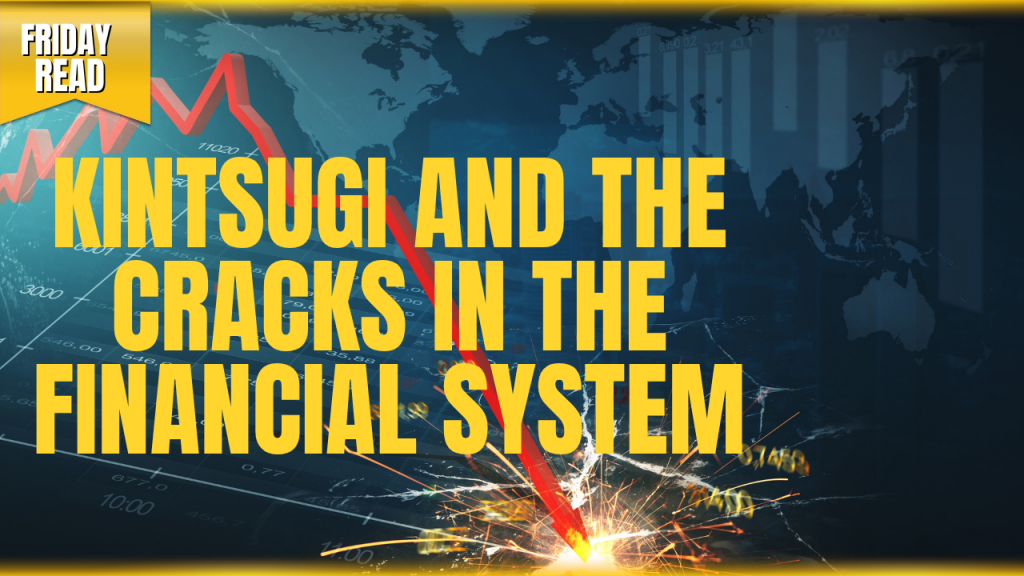
In Japan, when a finely made bowl is broken, it is not discarded or hidden away. It is repaired with lacquer mixed with gold powder, the seams left visible and gleaming. The practice is known as Kintsugi, or “golden joinery”, and it transforms what was once considered ruined into something of even greater worth. The cracks become part of the story, a record of fragility and repair, and a reminder that restoration can hold more beauty than denial ever could.
It is easy to see why the metaphor has travelled far beyond its origins. Kintsugi is invoked everywhere from psychology to business seminars, presented as a lesson in resilience and renewal. Yet it is within the financial world that the image feels most unsettlingly apt. For decades, the global monetary system has resembled a vessel that has been cracked and reassembled one too many times. Each crisis leaves its own hairline fractures, each rescue adds another coat of lacquer, and those responsible insist that the structure is sound.
Debt has become a permanent feature rather than a temporary measure. Monetary policy is no longer a tool of discipline but of defence. Every time a fissure appears, it is met with a fresh infusion of liquidity, a new acronym, a carefully worded reassurance that everything remains under control. The result is not repair in the true sense, but an elaborate performance of stability, one that relies on confidence rather than craft. The artisans of Kintsugi would never rush their work. They would recognise that the longer the pieces lie apart, the more intricate and expensive the repair becomes. The same can be said for an economy whose cracks have been left unattended for far too long.
There is an irony in how the world’s financial custodians have responded to this growing fragility. The same institutions that presided over decades of monetary experimentation are now among the most active buyers of gold. The recent surge in central bank demand is not a rediscovery of faith but a reinforcement of it, a quiet acknowledgment that the lacquer of policy alone cannot hold everything together. Gold, for all its ancientness, is the one material that still carries weight when words have lost theirs.
In contrast, many Western economies continue to treat gold as a curiosity, a remnant from a more superstitious age. The emphasis remains on policy innovation, on ever more complex instruments designed to smooth the next shock before the last one has settled. But as with any object that has been repeatedly repaired, each intervention risks creating new weaknesses. The more elaborate the fix, the greater the dependency on belief.
The story brings to mind the old fable of The Ant and the Grasshopper. The Ant, busy and unromantic, spends its summer gathering food for the winter, while the Grasshopper sings in the sun. When the frost arrives, the Ant has shelter, and the Grasshopper has regret. The lesson was not about joyless thrift, but about foresight and the acceptance that seasons change. In financial life, both personal and collective, the same truth applies. It is easier to prepare during the warmth of prosperity than to rebuild in the cold of crisis.
Our personal finances are not exempt from the same laws. A sudden job loss, an unexpected tax rise, or a period of inflation can expose how thin our safety nets really are. Yet, like Kintsugi, repair remains possible, and even transformative, if it is done with the right material. Gold, unlike policy, does not require trust to function. It does not default, it does not corrode, and it does not depend on the good intentions of its issuer. It is the form of value that needs no apology.
As the world’s economic bowl continues to rattle on the table, it is worth asking who will be ready when the next fracture appears. The institutions are gathering gold, though perhaps as much to protect themselves as to prepare for us. Individuals would do well to learn from both the Ant and the artisan, storing something of permanence now, before the cracks widen further. After all, every repair, whether of pottery or of wealth, is easier and far less costly when begun early.
Buy Gold Coins

Buy gold coins and bars and store them in the safest vaults in Switzerland, London or Singapore with GoldCore.
Learn why Switzerland remains a safe-haven jurisdiction for owning precious metals. Access Our Most Popular Guide, the Essential Guide to Storing Gold in Switzerland here.
Receive Our Award Winning Market Updates In Your Inbox – Sign Up Here





